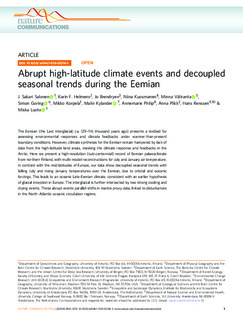| dc.contributor.author | Salonen, J. Sakari | |
| dc.contributor.author | Helmens, Karin F. | |
| dc.contributor.author | Brendryen, Jo | |
| dc.contributor.author | Kuosmanen, Niina | |
| dc.contributor.author | Väliranta, Minna | |
| dc.contributor.author | Goring, Simon | |
| dc.contributor.author | Korpela, Mikko | |
| dc.contributor.author | Kylander, Malin | |
| dc.contributor.author | Philip, Annemarie | |
| dc.contributor.author | Plikk, Anna | |
| dc.contributor.author | Renssen, Hans | |
| dc.contributor.author | Luoto, Miska | |
| dc.date.accessioned | 2019-02-14T10:15:24Z | |
| dc.date.available | 2019-02-14T10:15:24Z | |
| dc.date.created | 2018-09-05T13:06:58Z | |
| dc.date.issued | 2018 | |
| dc.identifier.citation | Nature Communications. 2018, 9:2851. | nb_NO |
| dc.identifier.issn | 2041-1723 | |
| dc.identifier.uri | http://hdl.handle.net/11250/2585412 | |
| dc.description | Open Access This article is licensed under a Creative Commons Attribution 4.0 International License, which permits use, sharing, adaptation, distribution and reproduction in any medium or format, as long as you give appropriate credit to the original author(s) and the source, provide a link to the Creative Commons license, and indicate if changes were made. The images or other third party material in this article are included in the article’s Creative Commons license, unless indicated otherwise in a credit line to the material. | nb_NO |
| dc.description.abstract | The Eemian (the Last Interglacial; ca. 129–116 thousand years ago) presents a testbed for assessing environmental responses and climate feedbacks under warmer-than-present boundary conditions. However, climate syntheses for the Eemian remain hampered by lack of data from the high-latitude land areas, masking the climate response and feedbacks in the Arctic. Here we present a high-resolution (sub-centennial) record of Eemian palaeoclimate from northern Finland, with multi-model reconstructions for July and January air temperature. In contrast with the mid-latitudes of Europe, our data show decoupled seasonal trends with falling July and rising January temperatures over the Eemian, due to orbital and oceanic forcings. This leads to an oceanic Late-Eemian climate, consistent with an earlier hypothesis of glacial inception in Europe. The interglacial is further intersected by two strong cooling and drying events. These abrupt events parallel shifts in marine proxy data, linked to disturbances in the North Atlantic oceanic circulation regime. | nb_NO |
| dc.description.abstract | Abrupt high-latitude climate events and decoupled seasonal trends during the Eemian | nb_NO |
| dc.language.iso | eng | nb_NO |
| dc.rights | Navngivelse 4.0 Internasjonal | * |
| dc.rights.uri | http://creativecommons.org/licenses/by/4.0/deed.no | * |
| dc.title | Abrupt high-latitude climate events and decoupled seasonal trends during the Eemian | nb_NO |
| dc.type | Journal article | nb_NO |
| dc.type | Peer reviewed | nb_NO |
| dc.description.version | publishedVersion | nb_NO |
| dc.rights.holder | © The Author(s) 2018 | nb_NO |
| dc.source.pagenumber | 10 | nb_NO |
| dc.source.volume | 9:2851 | nb_NO |
| dc.source.journal | Nature Communications | nb_NO |
| dc.identifier.doi | 10.1038/s41467-018-05314-1 | |
| dc.identifier.cristin | 1606913 | |
| cristin.unitcode | 222,58,1,0 | |
| cristin.unitname | Institutt for natur, helse og miljø | |
| cristin.ispublished | true | |
| cristin.fulltext | original | |
| cristin.qualitycode | 2 | |

